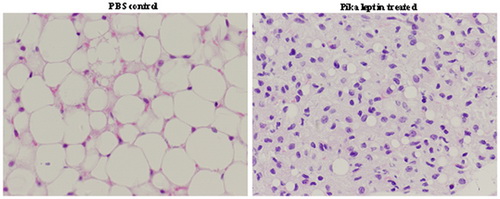1. Background
Environmental stress can accelerate the directional selection and evolutionary rate of specific stress-response proteins to bring about new or altered functions, enhancing an organism's fitness to challenging environments. Plateau pika (Ochotona curzoniae), an endemic and keystone species on Qinghai-Tibetan Plateau, is a high hypoxia and low temperature tolerant mammal with high resting metabolic rate and non-shivering thermogenesis to cope in this harsh plateau environment. Leptin is a key hormone related to how these animals regulate energy homeostasis. Previous molecular evolutionary analysis helped to generate the hypothesis that adaptive evolution of plateau pika leptin may be driven by cold stress.
2. Methodology/Principal Findings
To test the hypothesis, recombinant pika leptin was first purified. The thermogenic characteristics of C57BL/6J mice injected with pika leptin under warm (23±1°C) and cold (5±1°C) acclimation is investigated. Expression levels of genes regulating adaptive thermogenesis in brown adipose tissue and the hypothalamus are compared between pika leptin and human leptin treatment, suggesting that pika leptin has adaptively and functionally evolved. The results show that pika leptin regulates energy homeostasis via reduced food intake and increased energy expenditure under both warm and cold conditions. Compared with human leptin, pika leptin demonstrates a superior induced capacity for adaptive thermogenesis, which is reflected in a more enhanced β-oxidation, mitochondrial biogenesis and heat production. Moreover, leptin treatment combined with cold stimulation has a significant synergistic effect on adaptive thermogenesis, more so than is observed with a single cold exposure or single leptin treatment.
3. Conclusions/Significance
These findings support the hypothesis that cold stress has driven the functional evolution of plateau pika leptin as an ecological adaptation to the Qinghai-Tibetan Plateau.

Figure. Histomorphology of white adipose tissue from pika leptin-treated and PBS-treated mice.
Hematoxylin/eosin staining of WATsections from PBS control group and pika leptin-treated group.
Additional Information:
1. Author Information:Jie Yang1, Timothy G. Bromage2, Qian Zhao3, Bao Hong Xu4, Wei Li Gao4, Hui Fang Tian4, Hui Jun Tang1,Dian Wu Liu1*, Xin Quan Zhao5*
Correspondence: dwliu56@yahoo.com.cn (DWL); xqzhao@nwipb.ac.cn (XQZ)
2. Published : June 16, 2011,PLoS ONE 6(6): e19833. doi:10.1371/journal.pone.0019833
